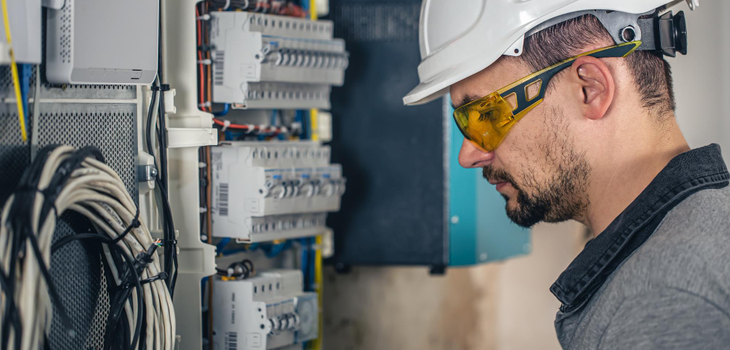Industrial Electrical Safety Protocols: Best Practices For Workplace Protection

Industries today depend heavily on electricity as their primary source of power. Over 90 per cent of companies worldwide rely on electricity. Despite this importance in the industrial space, electricity can pose health risks in workplaces. So, adequate safety protocols are needed to protect employees from electrical hazards and improve their working conditions.
Knowing the dangers of using electricity can help us determine the safety measures needed to prevent accidents. We focus on providing you with industrial electrical protocols to avoid workplace hazards. Read along.
Actions That Could Result In Electrical Hazards
Three primary hazards could occur when using electric equipment in industries: electrical fire, electric shocks and arc flashes. All these can lead to severe injuries like burns, cardiac problems and even death.
But there are other hazards, and we'll be discussing them further:
1. Shock due to malfunctioning appliances
It is expected to find faulty electrical equipment in large work areas. In most cases, these equipment have exposed wires. So, if a person comes in contact with these exposed wire parts, it can lead to shock.
2. Improper use of electrical equipment
Improper use of electrical equipment in workspaces can lead to severe hazards like fires and electric shocks. Common mistakes like overloading outlets, using damaged cords or plugs, and operating devices near water increase one's risks of electrical hazards. Plus, ignoring manufacturer safety guidelines can make these dangers worse.
3. Lack of personal protective equipment( PPE)
Not using personal protective equipment (PPE) in workspaces can lead to severe injuries and health risks. Without PPE like gloves, safety goggles, and helmets, workers are more vulnerable to cuts, burns, chemical exposure, and head injuries. PPEs act as barriers against hazards, and neglecting them increases the chances of accidents and long-term health problems. Ensuring all workers have and use the appropriate PPE is crucial for maintaining a safe and healthy work environment.
Industrial Electrical Safety Protocols
Having discussed actions that could lead to workspace accidents, this section discusses workspace protection protocols and the importance of industrial electrical safety protocols.
- Avoid contact between electrical equipment and conducting materials like water, iron and steel to prevent electrocution.
- Confirm that electrical equipment is unplugged by pulling on the plug head rather than the cord. Pulling the cord could damage the equipment and threaten the lives of both employers and employees.
- Inspect all electrical equipment daily to prevent further damage.
- Only qualified personnel should be allowed to handle live wire; no employee engagement.
- Electrical equipment should be de-energized during repair to prevent electrical accidents.
- Employees should have basic electrical hazard recognition training to spot hazards quickly and inform the necessary personnel.
- Employees should be given Personal protective equipment ( PPE), such as protective eyewear, insulating gloves, and other personal protective equipment ( PPE), to protect them from hazards when using electrical equipment. Employees should also be trained to use them and ensure they use them when needed. To ensure maximum safety and productivity.
How to Control Hazards Caused by Electrical Equipment
If someone gets an electrical shock, try to turn off the power source if you can. Suppose you can't use a non-conductor that doesn't conduct electricity, like wood or plastic, to move the electrical source away from the person and yourself. Never touch the person directly with your bare hands.
If you are in an accident you cannot manage alone, you should immediately call for emergency help. Signs that the accident is beyond your control include severe injuries, multiple people involved, or significant property damage. In such cases, professional assistance is crucial to ensure everyone's safety and well-being.

Further, CPR could be a solution in severe cases, where it is done to revive the affected individual who is suspected of having a cardiac shock.
Finally, you should never attempt to extinguish electrical fires with water, as it can escalate the situation because water is a conductor.
In Conclusion
Industrial electrical protocols limit the risks of electrical hazards in workplaces. It also boosts employee confidence in the company and builds a safe workspace.
If you wish to implement industrial electrical protocols in your workspace, this article is for you. We carefully discussed workplace hazards and how to prevent them.
Overall, we uphold the importance of professional electrical services in preventing workplace hazards. Check out a list of handymen services on Moovick.
FAQ

1. What are the less-known electrical hazards in industrial settings that are often overlooked?
Lesser-known hazards include arc flash incidents, improper grounding, faulty lockout/tagout procedures, and the risks associated with static electricity build-up.
2. How can predictive maintenance technologies enhance electrical safety in industrial environments?
Predictive maintenance uses data analytics and sensors to predict equipment failures before they occur, thus preventing unexpected electrical malfunctions that can cause safety hazards.
3. What role do personal protective equipment (PPE) advancements play in enhancing electrical safety protocols?
Advances in PPE, such as arc-rated clothing and improved insulating gloves, provide better protection against electrical shocks and burns, contributing significantly to workplace safety.
4. How can human factors engineering be integrated into electrical safety protocols?
Human factors engineering focuses on designing systems and processes that account for human limitations and behaviour, ensuring that safety protocols are user-friendly and minimise the risk of human error.
5. What are the latest standards and regulations in industrial electrical safety that industries must comply with?
Recent updates to standards such as NFPA 70E, OSHA regulations, and IEC 60364 provide guidelines on electrical safety practices, risk assessments, and necessary training for personnel.
6. How can a robust safety culture be cultivated among employees to ensure adherence to electrical safety protocols?
Cultivating a safety culture involves regular training, open communication about safety concerns, leadership commitment to safety, and incentivising safe practices among employees.
Popular Articles

Why is Professional Flooring Installation Essential for Your Home?

Reverse culture shock: what is this and how do you deal with?

Moving Plants: Step-by-Step Guide to Effortless Plant Relocation

Top Money-Making Tasks in The Hague: Quick and Easy Ways to Earn

DIY Dilemma: When to DIY and When to Hire a Professional for Home R...

Move to Switzerland: Your Ultimate Guide

